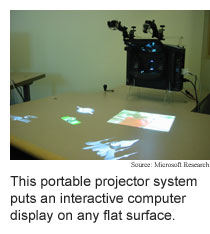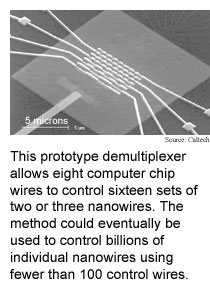
Week
of October 24, 2005
Portable
augmented reality
Computer monitors are by no means an endangered species, but it
is becoming increasingly apparent that they will soon be replaced for
many uses by floors, walls and table tops.
 The latest evidence: a Microsoft Research scientist has developed
a projector and computer vision system dubbed PlayAnywhere
that projects interactive computer-generated images without the need for
specially mounted cameras.
The latest evidence: a Microsoft Research scientist has developed
a projector and computer vision system dubbed PlayAnywhere
that projects interactive computer-generated images without the need for
specially mounted cameras.
Researchers have been reducing the cost and complexity of the
augmented reality systems in recent years. (See PCs
augment reality, TRN June 26/July 3, 2002)
The PlayAnywhere system goes further by packaging the components
into a single portable unit that doesn't require calibration. The system
consists of an NEC tabletop projector, an infrared light source, an infrared
camera and a computer. The device projects a 40-inch diagonal image onto
the surface it stands on.
Computer vision techniques allow users to use their hands to move,
rotate and scale projected virtual objects. The system tracks shadows
to determine where fingertips touch the surface; frame-to-frame pixel-level
changes determine hand motion. The system also keeps track of sheets of
paper in its view and can project images onto them.
The projector system could be used for games, educational software
and other interactive graphical computer applications.
(PlayAnywhere: A Compact Interactive Tabletop Projection-Vision
System, Symposium on User Interface Software and Technology (UIST 2005),
Seattle, October 23-26, 2005)
Bacteria simplifies fuel cells
Most fuel cells run on hydrogen that the cells first extract from
hydrocarbons like fossil fuels and plant matter. The extraction process,
however, also produces carbon monoxide, which inhibits the chemical reaction
that fuel cells use to generate electricity. Removing the carbon monoxide
usually requires high temperatures.
Researchers from the University of Oxford in England, Humboldt
University of Berlin in Germany and the Technical University of Berlin
in Germany have found that an enzyme
from an unusual bacteria makes fuel cells immune to the effects of carbon
monoxide.
Ralstonia eutropha strain H16 is one of several types of bacteria
that survive on hydrogen and live in oxygen-free or oxygen-poor environments.
Strain H16, however, can extract energy from hydrogen even in the presence
of oxygen.
A fuel cell anode, or positive electrode, coated with the bacterial
enzyme makes for a fuel cell that generates electricity even when the
fuel is a mix of nine parts carbon monoxide to one part hydrogen. The
enzyme's resistance to oxygen also means that the fuel cell does not require
the membrane typically used to keep oxygen away from the anode.
The discovery could significantly simplify the design fuel cells.
(Electrocatalytic Hydrogen Oxidation by an Enzyme at High Carbon
Monoxide or Oxygen Levels, Proceedings of the National Academy of Sciences,
published online October 24, 2005)
Nano error correction
Molecular-scale manufacturing promises extremely small, fast,
cheap devices like computers. Molecular-scale fabrication processes tend
to involve chemistry and biology, which are usually simple and inexpensive
to carry out, but also error-prone.
This makes it necessary for scientists working on nanofabrication
techniques to find ways to minimize errors or to design devices that tolerate
errors.
Taking a cue from nature, researchers from the University of Illinois
at Urbana-Champaign have developed an error
correction technique that uses DNA molecules to proofread assemblies
of nanoparticles held together by other DNA molecules and cut loose any
nanoparticle that does not belong. Nanoparticles are bits of metal or
semiconductor only a few nanometers wide. A nanometer is one millionth
of a millimeter.
The researchers tested the method by constructing clumps of 5-
and 13-nanometer gold particles held together by DNA and edited out the
smaller nanoparticles. The method could work with proteins or similar
molecules and could be used to assemble nanotubes and nanowires as well
as nanoparticles.
(Proofreading And Error Removal in a Nanomaterial Assembly, Angewandte
Chemie International Edition, published online October 17, 2005)
Addressing nanowire arrays
Smaller circuitry means smaller, faster, lower-power computers.
 One way to make smaller circuits is to use densely-packed nanowires,
which can be as small as a few millionths of a millimeter.
One way to make smaller circuits is to use densely-packed nanowires,
which can be as small as a few millionths of a millimeter.
A big challenge in developing nanoelectronics is connecting molecular-scale
circuits to today's merely microscopic electronics. The key is being able
to control a large number of nanowires with a much smaller number of larger
wires. Researchers from the California Institute of Technology have made
a nanowire
demultiplexer that is easier to fabricate than previous designs.
Several nanowire demultiplexers have been developed in recent
years, most notably by teams at Hewlett-Packard Labs and Harvard University
(see HP
maps molecular memory, TRN July 18, 2001 and Chemicals
map nanowire arrays, TRN January 28/February 4, 2004).
The Caltech demultiplexer is simpler than its predecessors because
it does not require mapping addresses or chemically modifying specific
parts of the nanowires. It uses a binary tree structure that allows 20
wires to address around 1,000 nanowires and 40 wires to address around
1,000,000 nanowires.
The device could also be used to connect arrays of nanoelectrodes
to control circuitry that would make biosensors capable of measuring the
inner workings of cells.
(Bridging Dimensions: Demultiplexing Ultrahigh-Density Nanowires
Circuits, Science, October 21, 2005)
Bits and pieces
A filter
brings color to electronic paper, silicon photonic crystal makes for
fast, low-power all-optical
memory chip; inorganic
semiconductor nanocrystals promise cheap, stable solar cells.
RSS Feeds: News Blog Books New: TRN's Internet Services TRN's Jobs Center News: Research News Roundup Research Watch blog Features: View from the High Ground Q&A How It Works Buy an ad link |
|
| Advertisements: |
|
Ad links: Clear History
Buy an ad link
|
TRN
Newswire and Headline Feeds for Web sites
|